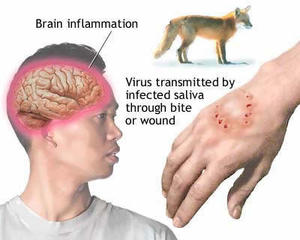BioterrorismTexas A&M bioterrorism research may yield rabies cure
Rabies infection is an unusual event in the United States, but it is a problem that kills more than 50,000 people around the world every year; the U.S. Department of Defense is funding research at Texas A&M on counter-measures to bioterrorism — but one of the most immediate outcomes of A&M’s research could be a cure for rabies

How rabies kills // Source: dilg.gov.ph
Rabies is one of the main targets of new research funded by the Department of Defense at Texas A&M University. What interests the Department of Defense is not so much what A&M is going to test but how the test plays out on cell samples exposed to a virus, a toxin, and a bacteria.
The drive behind the new research initiative: If attacks on U.S. troops or the public changes from conventional warfare to bioterrorism, the government wants to treat Americans quickly.
KVUE.com reports that what makes A&M uniquely poised for this research is what is stored in its unusually cold library: thousands of stem cells from mice. “If we screen thousands and thousands of cell lines each missing a gene, we could determine which genes, which part of your genes that the virus hijacks to hurt you, and once we know that then that gene becomes a target for new drugs that we can develop very rapidly to keep the virus from hurting you,” said Brett Giroir, Texas A&M Vice Chancellor for Research.
Texas A&M Contract Project Manager Deeann Wallis agreed. “We’re going after what’s in your body that makes you more sensitive or resistant to that bacterial infection,” she said.
Their findings could help fight bioterrorism and much more. “Now we’ll be immediately ready should any new emerging infectious disease come on board be of interest like SARS or H1N1 that nobody knows anything about,” she said.
One of the most immediate outcomes of A&M’s research could be a cure for rabies. Without immediate treatment, rabies almost always kills its victims. It is an unusual event in the United States, but it is a problem that kills more than 50,000 people around the world every year.
KVUE.com tells the story of Zack Jones, a 16-year-old who died from rabies four years ago after a bat flew into his room while he was sleeping. “We know the bat woke him up it was fluttering in his face — that’s what he said,” said Connie Jones, his mother.
He was not bitten, and Zach and his parents did not realize he could have contracted rabies so they missed the short window to get Zach treated. “He said mom there’s something really wrong with me. It’s my mind I can’t sleep I’m having little seizures,” his mother said he later told her.
The Jones’ said Zach’s condition puzzled doctors too. “They didn’t realize Zach had rabies and second, rabies had taken over Zach. He had a very small chance of survival,” his mother said.
One week after he noticed his first symptoms, rabies killed Zach. “This is something we’ve been praying for and hoping for,” his parents said about the ongoing research for a rabies cure.
